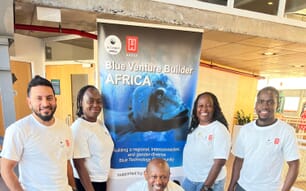Identity
Mugil cephalus Linnaeus, 1758 [Mugilidae]
FAO Names: En - Flathead grey mullet, Fr - Mulet à grosse tête, Es - Pardete

Biological features
Body cilindrical, robust. Head broad, its width more than width of mouth cleft; adipose eyelid well developed, covering most of pupil; upper lip thin, without papillae, labial teeth of upper jaw small, straight, dense, usually in several rows; mouth cleft ending below posterior nostril. Two dorsal fins; the first with four spines; the second with eight to nine soft rays; origin of first dorsal fin nearer to snout tip than to caudal fin base; origin of second dorsal fin at vertical between a quarter and a half along anal fin base. Anal fin with eight soft finrays. Pectoral fins with 16-19 rays; pectoral axillary about one-third length of fin. Pyloric caeca 2. Scales in leteral series 36-45. Colour back blue/green, flanks and belly pale or silvery; scales on back and flanks usually streaked to form longitudinal stripes; dark pectoral axillary blotch.
View SIDP Species fact sheet
Images gallery
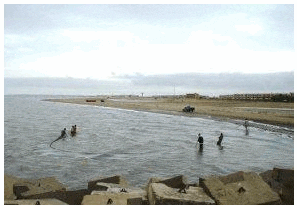
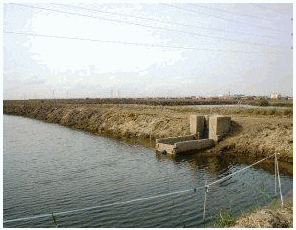
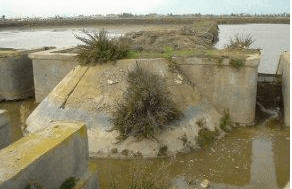
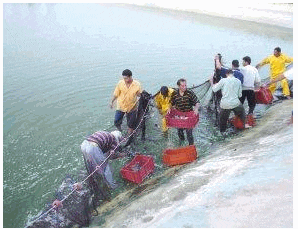
Profile
Historical background
Flathead grey mullet has been farmed for centuries in extensive and semi-intensive ponds in many countries. Subsistence farming in ponds and enclosures has been traditional in the Mediterranean region, South East Asia, Taiwan Province of China, Japan and Hawaii. Traditional vallicoltura methods employed for raising mullet are now advanced, especially in Italy.
Flathead grey mullet is a very important aquaculture species in Egypt, where its farming has been traditional in the hosha system in the delta region for centuries. Since the early 1960s, flathead grey mullet has also been cultured in semi-intensive ponds with tilapia and carps in Egypt.
In the Russian Federation mullet aquaculture has been practised in the Black Sea and Caspian Sea regions since 1930. This species was first introduced to be cultured with carp in Israel in 1957.
In the Philippines, mullet has been raised with milkfish since 1953. The intensive culture of mullet in Hong Kong was successful in fertilised ponds with the traditional practice of carp polyculture since 1940.
It has been reported that mullet have been farmed in India since ancient times; for example, it has been extensively cultured in Bengal, Madras and Kerala since 1947. However, does not report this in its statistical return to FAO; production is presumably 'hidden' within the category 'Osteichthyes'.
Flathead grey mullet is also cultured in Korea and is considered as an important foodfish in the southwest region. In Taiwan Province of China, nearly 40 per cent of the total commercial production (fisheries and aquaculture) of Mugil cephalus has been pond reared since the 1960s, being cultured with carp in ponds.
In the US, mullet has been cultured as bait fish since the 1940s. Small-scale trials of mullet vulture have been carried out in Saudi Arabia and other Gulf States.
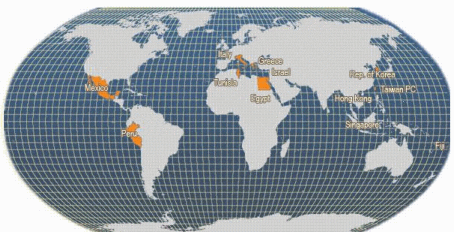
Habitat and biology
Mugil cephalus is cosmopolitan in the coastal waters of most tropical and subtropical zones. In the western Atlantic Ocean, it is found from Nova Scotia, Canada south to Brazil, including the Gulf of Mexico. It is absent in the Bahamas and the Caribbean Sea. In the eastern Atlantic Ocean, the striped mullet occurs from the Bay of Biscay (France) to South Africa, including the Mediterranean Sea and the Black Sea. The eastern Pacific Ocean range includes southern California south to Chile.
The flathead grey mullet is catadromous, frequently found coastally in estuaries and freshwater environments. Adult mullet have been found in waters ranging from zero salinity to 75 per cent, while juveniles can only tolerate such wide salinity ranges after they reach lengths of 4–7 cm. Adults form huge schools near the surface over sandy or muddy bottoms and dense vegetation and migrate offshore to spawn in large aggregations. The larvae move inshore to extremely shallow water, which provides cover from predators as well as a rich feeding ground. After reaching 5 cm in length, these young mullet move into slightly deeper waters.
Flathead grey mullet is a diurnal feeder, consuming mainly zooplankton, dead plant matter, and detritus. Mullet have thick-walled gizzard-like segments in their stomach along with a long gastrointestinal tract that enables them to feed on detritus. They are an ecologically important link in the energy flow within estuarine communities. Feeding by sucking up the top layer of sediments, flathead grey mullet remove detritus and microalgae. They also pick up some sediment which functions to grind food in the gizzard-like portion of the stomach. Mullet also graze on epiphytes and epifauna from seagrasses as well as ingest surface scum containing microalgae at the air-water interface. Larval flathead grey mullet feed primarily on microcrustaceans. Copepods, mosquito larvae, and plant debris have been found in the stomach contents of larvae under 35 mm in length. The amount of sand and detritus in the stomach contents increases with length, indicating that more food is ingested from the bottom substrate as the fish matures.
Trials on the artificial propagation of flathead grey mullet have been carried out, but most of the commercial aquaculture production of flathead grey mullet still depends on fry collected from the wild, which is cheaper.
Production
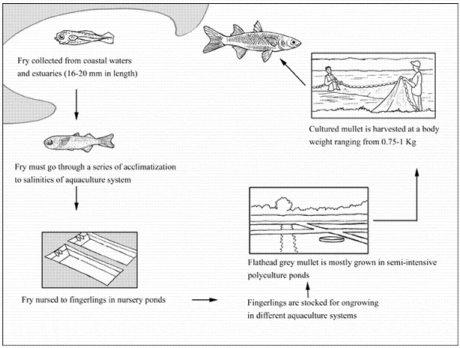
Production systems
Seed supply
Most of the flathead grey mullet fry used in commercial aquaculture are collected from the wild, especially in the Eastern and Southern Mediterranean, Saudi Arabia and Gulf States and South East Asia. Seed produced through artificial propagation is used on a limited scale in Italy and Hawaii.
During the autumn and winter months adults migrate to the sea in large aggregations to spawn. Fecundity is estimated as 0.5–2.0 million eggs per female, depending upon the adult size. Hatching occurs about 48 hours after fertilization, releasing larvae approximately 2.4 mm long. When the larvae are 16–20 mm, they migrate to inshore waters and estuaries, where they can be collected for aquacultural purposes during late August to early December.
Shoals of fry are collected by fine seine nets, transported in seawater to hapas or shore aggregation tanks for a few hours. They are then transported by trucks to separate nursery units, or nursery facilities in grow-out farms. On arrival, they need to be acclimatised, especially in terms of salinity; this takes place over several hours, during which water from the nursery pond is gradually added and mixed with the transport water. Mortality rates of up to 100 per cent can occur during the following two weeks if this process is neglected or not properly carried out before stocking fry into the nursery.
Hatchery production
Full-scale commercial production of Mugil cephalus is not yet common. Induced spawning and production of fry has been achieved on an experimental and semi-commercial basis in the US and Taiwan Province of China, and the production of mullet fry on a limited scale for aquaculture has been reported in Italy, Israel and Egypt.
In these systems large numbers of sexually mature individuals (over two years of age, 32–50 cm long and 1.0–2.1 kg each) are kept under optimum environmental conditions with limited physical disturbance. Prior to spawning, fish are kept at 32–35‰ and 12–15 °C.
Ripe fish are selected and placed in plastic or fibreglass tanks filled with seawater saturated with oxygen at a 2–3:1 male:female ratio shortly before spawning. Females are injected with regulated and successive doses (2–3 injections) of pituitary gonadotropin. Females spawn 12 hours after the last injection.
Spawning is heralded by a violent quivering of the male, which liberates sperm as a response of the release of eggs. Eggs are produced at a rate of 650–850/g female body weight. Mullet eggs are spherical (880–980 µm) and transparent, with a smooth surface and a single large oil globule making the egg extremely buoyant. Eggs are carried with the overflow of water, sieved and transferred to incubation jars. Eggs are incubated at a temperature of 22–24 °C in seawater (30–32‰) saturated with oxygen. Hatching takes place after 50–64 hours.
After hatching, the larvae are transferred to fibreglass indoor tanks and fed with live food (rotifers, and later with Artemia nauplii). Larvae are kept in indoor tanks for 14 days, and then transferred to larger tanks until they reach 10–2 mm before transport to outdoor nursery ponds.
Nursery
After acclimatisation, fry are stocked in earthen nurseries at high densities (up to 125/m²), where they depend mainly on natural food. From 2.5 to 5.0 tonnes/ha of animal manure are added to the soil before filling with water; then chicken manure and chemical fertilizers (usually phosphate and nitrates) are added in suitable amounts on a weekly basis to keep secchi disc readings of 20–30 cm. Rice or wheat bran is sometimes used as an additional source of food.
Fry are kept in the nursery ponds for 4–6 months (from August or November till April) until they are about 10 g BW. Optimum temperatures are 20–26 °C, both in the nursery and grow-out stages. The fingerlings are then caught, either by draining the nursery ponds into catch ponds or by netting. Over-wintered mullet fingerlings are sold for ongrowing in various culture systems but especially for semi-intensive aquaculture. In the rare cases that fry supply exceeds demand, they are retained and grown-on to market size in the nurseries.
Ongrowing techniques
In many countries mullet fry and fingerlings are stocked in inland lakes and reservoirs as a form of fisheries enhancement (culture-based fisheries). They have been transferred into inland water lakes of the El Fayyum area of Egypt since the 1920s, and into the Black Sea and Caspian Sea regions of Russia since 1930.
Cultured flathead grey mullet are usually grown in polyculture in semi-intensive ponds and netted enclosures in shallow coastal waters. Mullet can be polycultured successfully with many other fish, including common carp, grass carp, silver carp, Nile tilapia and milkfish, and can be reared in freshwater, brackishwater and marinewater.
Prior to stocking, aquaculture ponds are prepared by drying, ploughing and manuring with 2.5–5.0 tonnes/ha of cow dung. Ponds are then filled to a depth of 25–30 cm and kept at that level for 7–10 days to build up a suitable level of natural feed. The water level is then increased to 1.5–1.75 m and fingerlings are stocked. Productivity (measured by secchi disc – see nursery section) is kept at the required level by adding chicken manure and/or chemical fertilizers. Optimal dissolved oxygen is maintained by the use of various types of aerators, especially after sunset. Extruded feed is supplied to semi-intensive ponds to cover the feeding requirements of both carps and tilapia grown in the same ponds.
The growing season is normally about 7–8 months. If mullet are monocultured, manuring may be sufficient to reach the required feed level. In many cases, mullet has been found to feed directly on chicken manure and good levels of production have been recorded. Growth is checked by sampling, and if growth rates are not as expected, rice and/or wheat bran is added daily in amounts of 0.5–1 per cent of biomass to supplement the natural feed in ponds. When mullet are reared in polyculture, they are usually stocked with tilapia, common carp and silver carp. In this case, feeding and fertilization programmes are usually targeting the other cultured species and the mullet feed on the natural feed, detritus and feed leftovers.
Acclimatized to the appropriate salinity, and stocked as 10–15 g individuals at 6 175–7 410/ha, a harvest of 4.3–5.6/tonnes/ha/crop can be obtained. In semi-intensive polyculture with tilapia and carp, mullet fingerlings are stocked at 2 470–3 705/ha together with 1 850–2 470/ha of 100 g common carp juveniles and 61 750–74 100/ha 10–15 g Nile tilapia fingerlings. Total harvests are typically 20–30 tonnes/ha/crop, of which 2–3 tonnes are mullet.
After an ongrowing season of 7–8 months in either culture systems in the subtropical region, flathead grey mullet reach 0.75–1 kg; if kept for two ongrowing seasons, they reach 1.5–1.75 kg each. Rearing for a second year depends on the market requirements; in some countries mullets are marketed at a size of 1.5 kg and larger. The two seasons are continuous, as fish are kept in ponds for over wintering, fish then grow in the same ponds through the next spring and summer until they reach that size. As usual, the choice of rearing technique depends on market demand and economics.
Feed supply
In monoculture, mullet feeds on natural food and on the by-products of grain mills and rice polishing plants. In polyculture, manufactured extruded pellets are produced either in feed mills specialized in the production of fish feed or, in many cases, in chicken feed mills that have a line for fish feed production. Feed is formulated according to the dietary requirements of the major cultured species (i.e. tilapia and common carp).
Harvesting techniques
Harvesting can be partial in ponds or net enclosures. Daily harvesting, according to market demand, can be carried out using gillnets of suitable mesh size. Nets are stretched in a zigzag line across ponds at sunset and collected at the early morning.
In semi-intensive culture, total drain-harvesting is used in late autumn or early winter. Fish usually move with the flow of water to a concrete catch pond at the pond outlet. A seine net can be used to collect those that do not reach the catch pond.
Handling and processing
Fish are collected from the catch ponds by scoop nets and transferred into plastic boxes, washed in running water, and then sorted according to species and sizes on a sorting table. Sorted fish are weighed and packed in plastic boxes with crushed ice or ice flakes.
In the Mediterranean region, mullet is usually marketed fresh or chilled. Fish are marketed whole but gutted mullet are accepted. Harvested mullet is marketed daily and consumed fresh and never kept on ice for more than one day. Older mullet is considered of inferior quality and does not usually gain a good price. Frozen mullet is considered of much lower value in this region. Mullet is also preserved by wet salting and consumed salted.
Production costs
Production costs vary considerably, depending on the culture system, geographical area and the level of technology applied. Costs also vary depending whether hatchery-produced fry or fingerlings are used or not, or the system is monoculture or polyculture. In Egypt, hatchery-produced 10 g fingerlings cost USD 0.3 each, while wild fingerlings of the same size cost USD 0.1–0.12. These figures may be different in other regions, where the collection of wild fry is forbidden or if hatchery production is well established. The total cost of producing 1 kg of flathead grey mullet in semi-intensive aquaculture in Egypt is USD 0.75–1.00.
Diseases and control measures
| DISEASE | AGENT | TYPE | SYNDROME | MEASURES |
|---|---|---|---|---|
| Iridoviral disease | Iridovirus | Virus | Systemic disease; congested fins; increased mucus production; highest mortality at lower temperatures (<24 °C) | Vaccination; environmental improvement |
| Red pest of eels, red sore, red boil, saltwater furunculosis | Vibrio anguillarum | Bacterium | Systemic infection; acute haemorrhagic and septicaemic disease with mass mortality; anorexia; darkening; abdominal distension, dermal haemorrhages; skin ulcers; occurrence of exophthalmos | Vaccination; environmental improvement |
| Streptococcosis | Streptococcus faecalis | Bacterium | Haemorrhagic areas on body surface | Antibacterial drugs in feed; environmental improvement |
| Bacterial fin rot | Aeromonas hydrophila; Flexibacter columnaris | Bacterium | Breakdown of tissues between fin rays (fin rot) | Antibacterial bath; environmental improvement |
| Motile aeromonas septicaemia | Aeromonas hydrophyla; A. caviae and A. sobria | Bacterium | Systemic infection; acute haemorrhagic and septicaemic disease; haemorrhagic spots on the skin and base of fins; ulcers and skin necrosis; exophthalmia and dropsy | Environmental improvement; antibacterial drugs in feed |
| Gill myxobolosis | Myxobolus goensis | Protozoan parasite | Gill infestation | Environmental improvement |
| Sea lice | Caligus spp. | Copepod parasite | Infestation occurs commonly in the skin | Medicated bath; environmental improvement |
| Epizootic ulcerativesyndrome (EUS); red spot disease (RSD); mycotic granulomatosis (MG) | Aphanomyces invadans | Fungus | Skin ulcers | Environmental improvement |
Statistics
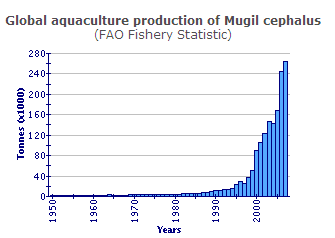
Egypt is by far the largest producer of farmed flathead grey mullet and production rapidly increased during the period 1998–2003. The Republic of Korea, Italy, Taiwan Province of China and Israel are also significant producers.
Market and trade
Flathead grey mullet has a good market in some countries, especially in the southern and eastern Mediterranean region. It is also consumed in many Asian countries. However, it is not a favourite fish in many other countries, such as non Mediterranean and Western Europe and the United States of America. Most, if not all, of the farmed mullet is consumed in the producing countries where increasing demand exists. There is no known export market. It is usually consumed fresh, but salted and fermented mullet is considered as a delicacy in Egypt and some other Arab countries.
Status and trends
Global production of cultured flathead grey mullet increased from 25 600 tonnes in 1997 to 147 000 tonnes in 2003. Most of the reported increase was a result of the increased production from Egypt, which is the largest producer (92 per cent in 2003). There are no clear trends in production in the other major countries rearing this species (Republic of Korea, Italy, Taiwan Province of China and Israel).
The future expansion of flathead grey mullet farming is limited because it depends mainly on wild fry. Egypt, the largest producer of cultured mullet, has only one experimental mullet hatchery that produces a few hundred thousand fry annually. While most of the cultured mullet in Italy originates from hatchery-produced fry, limited fry availability restricts potential limits expansion of the activity.
The future is therefore uncertain and the investment in this activity is declining. With the increasing desire of aquaculture producers to export their product, flathead grey mullet with its limited export potential, is becoming less attractive; the substitution of fish with higher market potential is becoming a trend.
Main issues
As aquaculture of flathead grey mullet depends largely on collection of wild fry, it is affecting the resources for capture fisheries. In countries where wild fry collection for aquaculture is practiced, social problems usually result from the competition for resources between fish farmers and fishermen. The farming activity is also practiced in areas that were previously parts of the natural fishing grounds.
Responsible aquaculture practices
Traditional aquaculture of flathead grey mullet has a limited negative effect on the environment. The issues concerning responsible aquaculture are the necessity to:
- Avoid the negative effects resulting from the collection of wild fry for aquaculture; the development of commercial fish hatcheries is highly desirable.
- Improve aquaculture systems to significantly increase the survival of fry, thus reducing the pressure on wild stocks.
- Improve aquaculture management to significantly reduce the negative effects of intensification on the environment.
- Protect artisanal fisheries grounds and fish stocks, which can be drastically affected by the expansion in coastal and lagoon aquaculture.
- Adhere to the FAO Code of Conduct for Responsible Fisheries to ensure that mullet culture remains sustainable and responsible.
April 2010




